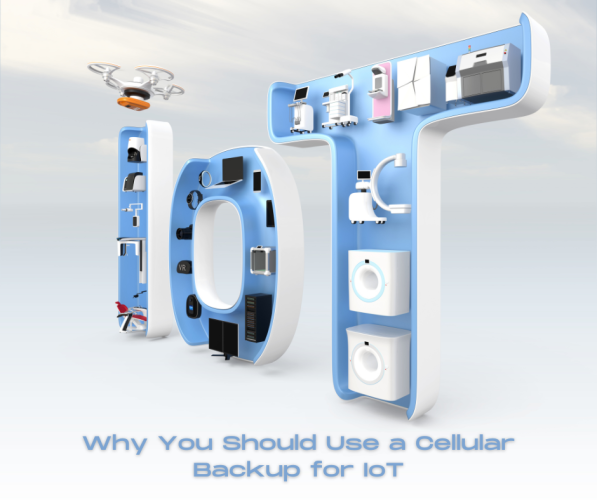
The Internet of Things (IoT) is transforming the world as we know it. It has the potential to revolutionize the way we live, work, and communicate, with billions of connected devices already in use around the world. IoT has a wide range of applications, from smart homes and cities to healthcare, industrial, and transportation. With this increased connectivity comes the need for reliable and resilient IoT networks.
IoT networks are designed to connect billions of devices in real-time, providing access to information and data when and where it’s needed. This also means IoT networks are vulnerable to disruptions and outages. A single point of failure in the network can result in significant consequences, such as the loss of critical data, loss of productivity, and even financial losses. This is where cellular Internet can help.
Since 5G is becoming increasingly available, IoT devices and applications have become more sophisticated and data-intensive, which has led to the need for better connectivity and faster data transfer rates. Cellular provides a reliable and secure connection, even when other communication channels are unavailable. This is especially important for IoT devices that need to function in remote or challenging environments, where a reliable and stable connection is essential. For example, IoT devices used in agriculture, mining, or oil and gas production often operate in remote locations where traditional fixed-line networks are not available. Cellular can provide a primary or backup connection that keeps these devices online and functioning, even in the event of a network outage or disruption.
Speed and Reliability
In addition to providing a reliable backup connection, cellular can also improve the speed and reliability of IoT networks. Cellular networks are designed to handle large amounts of data traffic, and can often provide faster and more reliable connections compared to traditional fixed-line networks. This is because cellular networks use the latest technology and have the ability to dynamically allocate bandwidth based on demand, providing a better user experience.
This improved speed and reliability can be particularly useful for IoT devices that require real-time data transfer, such as those used in healthcare, industrial, or transportation applications. All can benefit from high-speed connectivity, low latency, and advanced security features that some LTE, and 5G-enabled routers and gateways can provide.
Enhanced Security
Another advantage of using a cellular backup for IoT is security. IoT networks can be vulnerable to cyber attacks and hacking, and cellular Internet provides an additional layer of security to protect against these threats. Cellular networks are designed to be secure and reliable, and use encryption and other security measures to protect against unauthorized access. This includes secure authentication methods, network-level encryption, and firewalls to prevent unauthorized access to sensitive data.
In addition, cellular networks are subject to strict regulatory and compliance requirements, which ensure that they are secure and reliable. For example, in the European Union, mobile broadband networks must comply with the General Data Protection Regulation (GDPR), which sets strict rules on data protection and privacy. In the United States, mobile broadband networks must comply with the Federal Communications Commission (FCC) regulations, which set standards for network security and reliability.
It’s important to note that the security features offered by mobile broadband services can vary depending on the service provider and the specific plan or package you choose. Additionally, users should always take basic security precautions such as keeping their device and software up to date, using strong passwords, and avoiding suspicious websites and links.
Cellular and IoT
Cellular Internet can be used in IoT applications to provide connectivity to a wide range of devices and sensors, allowing them to communicate with each other and with cloud-based services. Here are some ways that cellular can be used in IoT applications:
- Remote monitoring: IoT devices can be deployed in remote locations to collect data and transmit it to the cloud using cellular connectivity. This data can then be analyzed to provide insights and improve operational efficiency.
- Asset tracking: Use cellular to track the location and status of assets, such as vehicles or shipping containers, in real-time. This allows organizations to optimize logistics and improve supply chain management.
- Smart homes: Cellular Internet can be used to connect smart home devices, such as thermostats, security cameras, and lighting, to the internet. This allows homeowners to remotely control and monitor their homes from anywhere.
- Wearables: When WiFi is not available, wearable devices, such as fitness trackers and smartwatches, use cellular to connect to the internet. This allows users to track their health and fitness data and receive real-time alerts and notifications, no matter where they are.
- Industrial automation: Connect industrial automation systems, such as robots and sensors, to the internet. This allows organizations to automate processes and optimize production.
Cellular backup for IoT provides a flexible connection, improved speed and reliability, and enhanced security for IoT devices. By leveraging the strengths of cellular Internet, organizations can ensure the resilience and reliability of their IoT networks, and safeguard against network disruptions and outages. If you’re looking to optimize your IoT network and ensure the success of your IoT initiatives, consider implementing a cellular backup for peace of mind and increased functionality. Whether you’re operating in remote locations or urban environments, a cellular backup can be a valuable investment for any organization looking to fully leverage the power of the Internet of Things.

